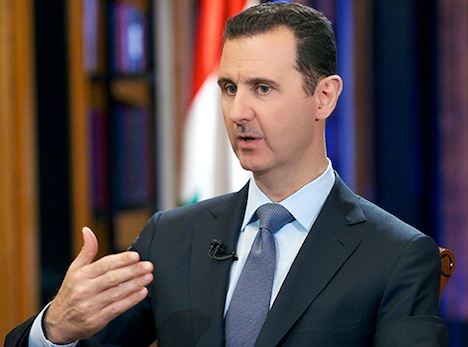It’s beginning to look a lot like the war in Syria is coming to an end — or, at a minimum, the nature of the two-year conflict is transforming into something quite different from what it was just a few days ago.![]()
![]()
As a freak snowstorm covered much of the Middle East, threatening thousands of refugees from exposure to the cold, the Syrian opposition crumbled into opposing camps after the Islamic Front ( الجبهة الإسلامية, al-Jabhat al-Islāmiyyah), a merger of seven jihadist rebel groups created in November, pushed opposition general Salim Idris out of power earlier this week from his perch as chief of staff of the Free Syrian Army (الجيش السوري الحر, al-Jaysh as-Sūrī al-Ḥurr) and executed several other moderate leaders in the Free Syrian Army. Idris, who was in Qatar at the time of the jihadist push, reportedly returned to Turkey, not to Syria.
The merger last month transformed the Islamic Front, whose most important member is the Salafist-backed and Saudi-funded Ahrar ash-Sham (حركة أحرار الشام الإسلامية ), into the largest rebel fighting unit within the Syrian opposition, with up to 45,000 fighters (compare that to between 20,000 and 40,000 fighters in the Free Syria Army). While the Islamic Front represents a much more pro-jihadist coalition than the moderate leadership of the Free Syrian Army, it’s important to keep in mind that it’s still separate from the most radical al Qaeda affiliates that are also fighting the Assad regime. But though the al Qaeda-affiliated Jabhat al-Nusra (al-Nusra Front, جبهة النصرة لأهل الشام), which itself has up to another 15,000 fighters, is not a member of the Islamic Front, the two work closely together. Another al Qaeda-affiliated group, the Islamic State of Iraq and the Levant (ISIS, الدولة الاسلامية في العراق والشام) boasts up to 15,000 more fighters. It’s still unclear whether the Islamic Front will supplant, oppose or cooperate with ISIS and the al-Nusra Front.
Another 40,000 Kurdish fighters operate in the relatively autonomist Kurdish territory in the far northeast of Syria.
No matter how much control Idris and the moderates still retain over the Free Syrian Army (and, well, it doesn’t seem like much), it’s clear to everyone that the opposition is now nearly as much at war with itself as with the Ba’athist regime of president Bashar al-Assad. The joint US and UK decision to suspend non-lethal aid to the northern Syria opposition reflects how seriously power has shifted away from the moderate FSA leadership and toward the more radical Islamic Front– US policymakers were probably distraught to hear that US supplies have now fallen under the control of the Islamic Front. (For the record, this is exactly why many policymakers opposed the call from John McCain, US senator from Arizona, to arm Syria’s opposition with fully lethal aid).
The week’s amazing putsch within the Syria opposition follows confirmation from a UN report that chemical weapons have been used at least four times in Syria’s civil war, including the massive attack in Ghouta last August, where over 1,000 Syrians died from exposure to sarin gas. Nonetheless, Assad continues to cooperate with the Organisation for the Prohibition of Chemical Weapons, and the OPCW is optimistic it can still meet the first December 31 deadline for the removal of the first trance of chemical weapons.
So how does the geopolitical stage look vis-à-vis the Syrian opposition these days? Continue reading Did Assad win the Syrian civil war this week?
